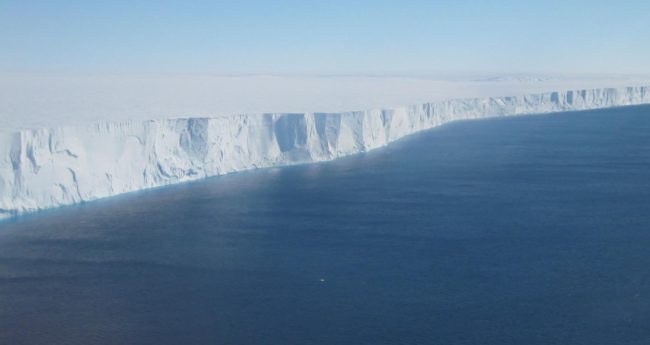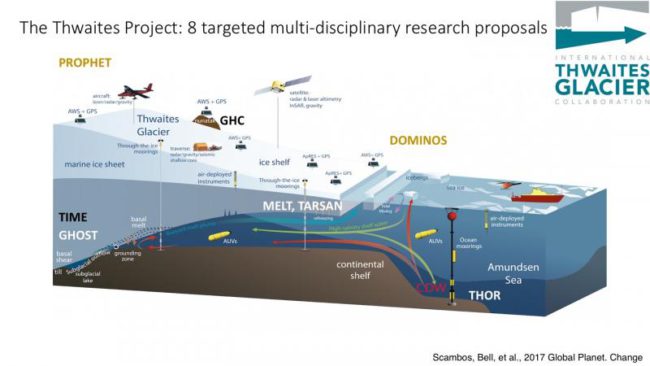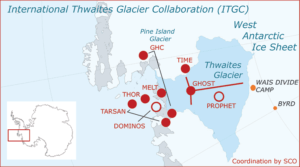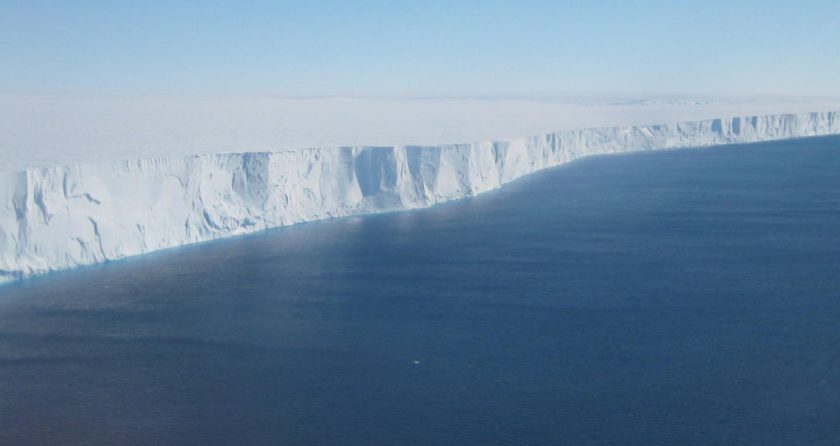
We have a news update from the International Thwaites Glacier Collaboration (ITGC) MELT project. Before we get into it, let’s do a quick bit of background.
What exactly is the International Thwaites Glacier Collaboration?
The vast and very remote Thwaites Glacier in the Antarctic is currently being intensively studied. For this effort the US National Science Foundation (NSF) and UK Natural Environment Research Council (NERC) have teamed up and formed the International Thwaites Glacier Collaboration (ITGC).
Why?
Over the past 30 years, the amount of ice flowing out of this 120-kilometer-wide region has nearly doubled. Overall the glacier is the size of the island of Britain, or the state of Florida, and it straddles some of the deepest bedrock in the southern continent.
What exactly are they doing?
The ITGU is split up into 8 distinct projects. Each has a very different scientific focus. There is also one overall coordinating project.

Each of the ITGC field projects, shown as red solid circles, has a principle geographic focus of their study, related to the processes they intend to study.

- The two modeling studies, PROPHET and DOMINOS are shown as open circles in orange.
- TIME is a study of how the boundary of the glacier evolves, and what the differences are between the slow-moving ice and underlying rock outside the glacier is versus the interior.
- GHOST is a traverse of the core of the glacier, looking at ice and bedrock characteristics with seismic and radar data.
- GHC will collect rock samples from either side of Thwaites Glacier to look for clues as to its recent past history—as will the THOR project, using marine sediments, bathymetric mapping, and oceanography.
- MELT and TARSAN both have a focus on the ice-ocean interaction at the point of contact between land, ice, and sea, looking at ocean circulation and rates of ice melt near the front of the glacier.
- SCO coordinates other projects.
Update from the ITGU MELT Team – 28th Jan 2020
The MELT team of scientists has observed, for the first time, the presence of warm water at a vital point underneath a glacier in Antarctica—an alarming discovery that points to the cause behind the gradual melting of this ice shelf while also raising concerns about sea-level rise around the globe.
“Warm waters in this part of the world, as remote as they may seem, should serve as a warning to all of us about the potential dire changes to the planet brought about by climate change,” explains David Holland, director of New York University’s Environmental Fluid Dynamics Laboratory and NYU Abu Dhabi’s Center for Global Sea Level Change, which conducted the research. “If these waters are causing glacier melt in Antarctica, resulting changes in sea level would be felt in more inhabited parts of the world.”
The recorded warm waters—more than two degrees above freezing—flow beneath the Thwaites Glacier, which is part of the Western Antarctic Ice Sheet. The discovery was made at the glacier’s grounding zone—the place at which the ice transitions between resting fully on bedrock and floating on the ocean as an ice shelf and which is key to the overall rate of retreat of a glacier.
Thwaites’ demise alone could have significant impact globally.
It would drain a mass of water that is roughly the size of Great Britain or the state of Florida and currently accounts for approximately 4 percent of global sea-level rise. Some scientists see Thwaites as the most vulnerable and most significant glacier in the world in terms of future global sea-level rise—its collapse would raise global sea levels by nearly one meter, perhaps overwhelming existing populated areas.
While the glacier’s recession has been observed over the past decade, the causes behind this change had previously not been determined.
“The fact that such warm water was just now recorded by our team along a section of Thwaites grounding zone where we have known the glacier is melting suggests that it may be undergoing an unstoppable retreat that has huge implications for global sea level rise,” notes Holland, a professor at NYU’s Courant Institute of Mathematical Sciences.
The scientists’ measurements were made in early January, after the research team created a 600-meter deep and 35-centimeter wide access hole and deployed an ocean-sensing device to measure the waters moving below the glacier’s surface. This device gauges the turbulence of the water as well as other properties such as temperature. The result of turbulence is the mixing of fresh meltwater from the glacier and salty water from the ocean.
It marks the first time that ocean activity beneath the Thwaites Glacier has been accessed through a bore hole and that a scientific instrument measuring underlying ocean turbulence and mixing has been deployed. The hole was opened on January 8 and 9 and the waters beneath the glacier measured January 10 and 11.
Another researcher, Keith Nicholls, a scientist with the British Antarctic Survey, added, “This is an important result as this is the first time turbulent dissipation measurements have been made in the critical grounding zone of the West Antarctic Ice Sheet.”
Climate Skeptic Claim: “Its a Volcano”
You might also see a claim that it is not climate change but rather is a volcano. This is a supposed rebuttal from climate denialisms.
The basis for that claim is study that was conducted by researchers at the Institute for Geophysics at the University of Texas at Austin (UTIG) and published in the Proceedings of the National Academy of Sciences. It analysed geothermal heat below the glaciers in West Antarctica and acknowledges that these sources — which include magma movement and volcanic activity — do contribute to some ice cap melting.
What do the Subject Matter Experts think?
“It is true that there are active volcanoes in West Antarctica, and so there may have been some local changes, but in most cases, at most times, volcanoes are not erupting under the ice,” Richard Alley, a geologist at Penn State, “This paper is exciting for modelers and geologists who focus on Antarctica, but it doesn’t tell you anything about why the ice is now thinning.”
While this form of geothermal heating does contribute to glacial melting, it does not necessarily mean… “climate alarmism has suffered yet another devastating setback.”
“People have to be careful when drawing hasty conclusions into how much volcanoes can affect glacial melting,” Eric Rignot, an earth science professor at University of California Irvine and a principal scientist at NASA (He is also the
“The fastest glacial changes are happening where the ocean is warmer,” Schroeder said. “Geothermal heating is not enough by itself to have caused the observed changes.”
“If you want to understand how the glaciers are changing, you can’t just look at the ice, you can’t just look at the climate system, you can’t just look at the geology, you have to look at the whole picture,”
Further Reading
- Key ITGU page that leads to each of the 8 Project Team pages
- My May 2018 posting about the Start of it all – Thwaites Glacier: Biggest ever Antarctic field campaign
- Press Releases 28th Jan 2020..
- ITGU – Scientists drill for first time on remote Antarctic Glacier
- NUY – Scientists Find Record Warm Water in Antarctica, Pointing to Cause Behind Troubling Glacier Melt
- In the media …
- Washington Post (30 Jan 2020) – Unprecedented data confirms that Antarctica’s most dangerous glacier is melting from below
- Phys.Org (29th Jan 2020) – Scientists find record warm water in Antarctica, pointing to cause behind troubling glacier melt
- General Information about Thwaites – What is the ice volume of Thwaites Glacier?
- Volcanoes?
